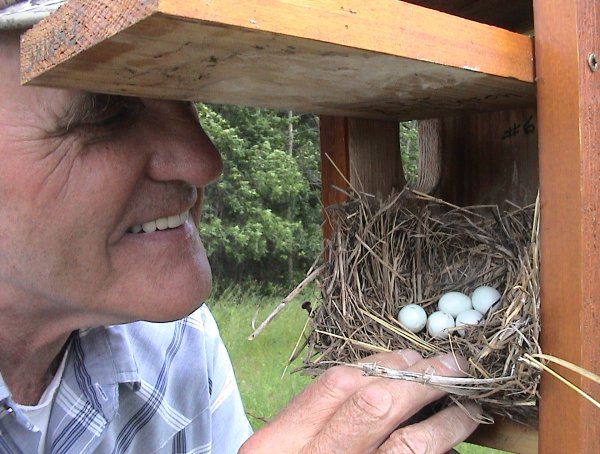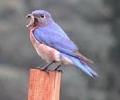First Year Bluebirder Bonanza
by Leif Marking
In the fall of 2002 Iler Anderson stopped by my farm with a friend who purchased several bluebird houses for his rural property. Iler listened as I explained to Homer the importance of predator protection with a PVC pipe over the steel fence post. Then I told them about the success our Brice Prairie Conservation Assoc. (BPCA) members were experiencing using NABS-style houses and spacing them 200 yards apart in bluebird habitats to reduce competition with other cavity nesters. I noticed that some of my enthusiasm was transferred to Iler even though he had never placed bluebird boxes before.
As Iler drove home to Spooner in Burnett Co., he began to ponder bluebirds, trails, spacing, monitoring, fledging, and eventually success. Suddenly, he realized he wanted to become a bluebirder. He called me soon after getting home and expressed his urgency to receive house plans and our orientation video. During winter he constructed 25 houses, and in spring he placed them in favorable bluebird habitats according to BPCA protocol. He negotiated sites and trail routes with local landowners, and amazingly, all of the houses were occupied by the end of May. Sixteen boxes were occupied with bluebirds, and nine with Tree Swallows.
Iler was so excited with this kind of success that he felt compelled to expand his trail. As he searched for ideal habitat sites, he realized more houses were needed. As he built and placed nest boxes, he recognized additional sites which had to be accommodated with urgency. By the end of June, fifteen additional houses were in place; nine occupied by bluebirds and six by Tree Swallows. What an exciting beginning for a first year bluebirder.
Production of bluebirds in the first 25 houses was excellent; 4.8 fledglings per box and 6.7 birds of both species. Although the second group experienced only a partial nesting season, the production rate was very satisfactory at 3.0 for bluebirds and 4.6 for combined species. Those 40 houses produced 167 bluebirds and 72 Tree Swallows for a production rate of 4.2 for bluebirds and 6.0 overall. Those bluebirds double nested in 18 houses, another good rating of productivity.
Iler demonstrated tremendous first year success using practical, reasonable, and proven procedures. He caught the bluebird fever, and bluebirds have become an important part of his retirement. Already he is anticipating more houses, success, and fulfillment for next nesting season.



 gmail.com
gmail.com